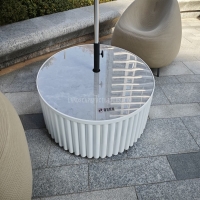Welcome to the website for landscape facilities products and knowledge.
How can a landscape bar counter be designed to create a seamless transition between a porch and a garden?
A well-designed landscape bar counter serves as the ultimate connector, blurring the boundaries between a sheltered porch and the lush openness of a garden. This architectural element is no longer just a functional space for mixing drinks; it is a pivotal design feature that orchestrates a harmonious flow between indoor comfort and outdoor serenity. The key to achieving this seamless transition lies in a multi-faceted approach that considers materials, form, structure, and purpose.
The most critical factor is material continuity. Selecting a countertop material that appears both indoors and outdoors visually stitches the two spaces together. A honed natural stone like bluestone or limestone, which has a textured, organic feel, is an excellent choice. Using the same stone for the bar top and the porch flooring or garden patio creates a powerful visual link. Alternatively, a long, uninterrupted slab of polished concrete can extend from the porch interior to the garden side, acting as a literal and figurative bridge. For a warmer aesthetic, a durable wood species like ipe or teak can be used for the countertop and repeated on porch ceiling beams or garden fencing.
The form and structure of the bar itself must be intentional. A peninsular or floating design is far more effective than a blocky, enclosed unit. The counter should be accessible from at least three sides, inviting movement around it and encouraging guests to flow from the porch to the garden. The structure should appear to grow from the landscape rather than be placed upon it. For instance, a bar counter built around an existing tree or one that incorporates a planter box filled with cascading herbs and flowers at its base effectively merges with the garden. Supporting the structure with sleek metal legs or a minimalist stone base, rather than a solid wall, maintains visual permeability and allows light and views to pass through.
Bi-folding or sliding glass windows installed above the bar counter on the porch side complete the transformation. When opened, they eradicate the barrier entirely, creating a true open-air serving hatch. This setup allows hosts to interact with guests in both zones simultaneously, fostering a unified social atmosphere. Integrating functional elements like a built-in ice bucket, a small sink with a brass or copper faucet (which develops a beautiful patina outdoors), and subtle under-counter lighting for evening ambiance elevates the experience. The lighting should be warm and low-level to complement the garden's mood without creating harsh glare.
Ultimately, this design philosophy transforms the bar into more than a utility; it becomes the heart of alfresco living. It is a place where one can sip a morning coffee while listening to the garden birds, host lively evening gatherings that spill effortlessly onto the lawn, and enjoy the changing seasons from a unique vantage point. By thoughtfully considering its role as a connector, a landscape bar counter dissolves the threshold, turning your porch and garden into one cohesive, enchanting living space.
Related search:

Recommendation
Round metal tube border design table with tempered glass or granite countertop on the top.